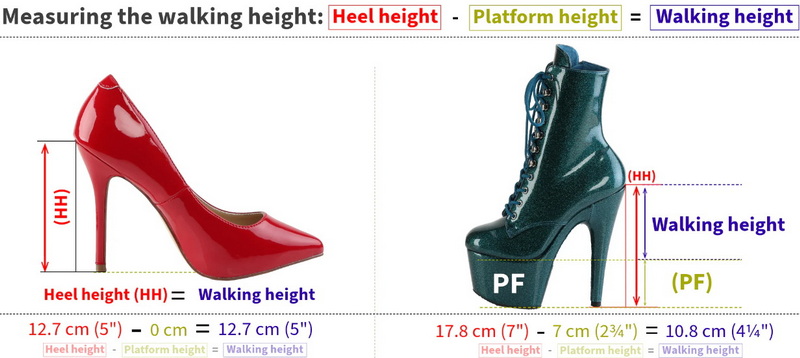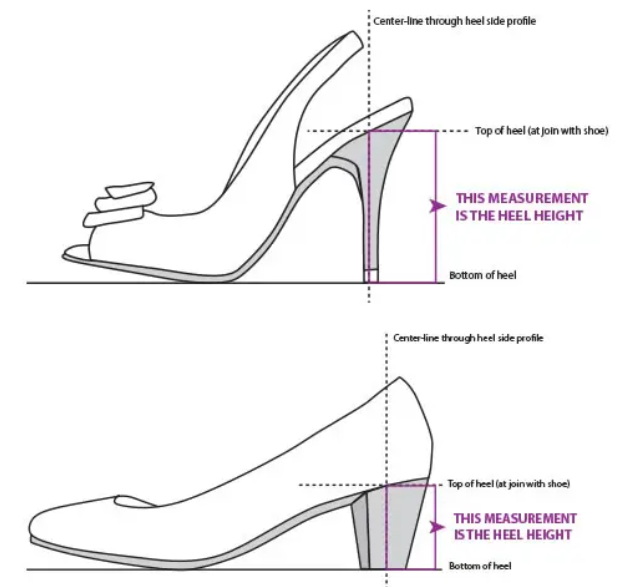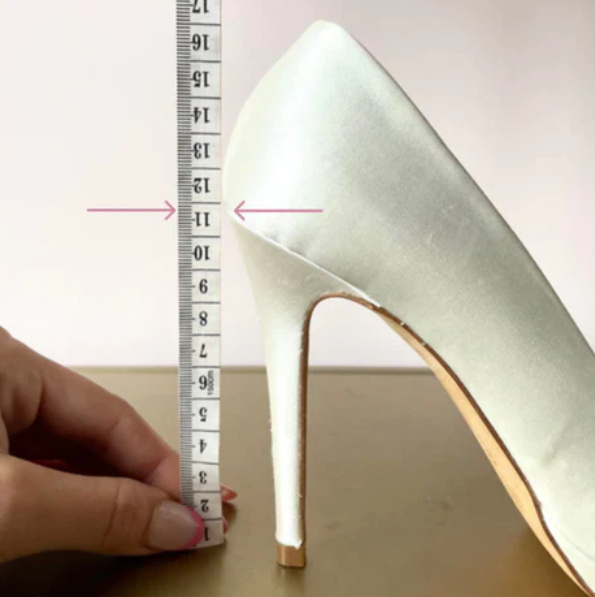Content Menu
● The Importance of Accurate Heel Measurements
● Step-by-Step Guide to Measuring Heel Height
>> 1. Gather Your Materials
>> 2. Prepare the Shoe
>> 3. Locate the Measurement Points
>> 4. Measure the Height
>> 5. Record the Measurement
● Types of Heels and Their Measurement Considerations
>> Stiletto Heels
>> Block Heels
>> Wedge Heels
>> Platform Heels
● Understanding Heel Height Categories
● Choosing the Right Heel Height
>> Comfort Level
>> Occasion
>> Foot Size
>> Health Considerations
● The Impact of Heel Height on Posture and Walking
● Tips for Measuring Heel Height Accurately
● The Role of Heel Height in Fashion and Style
● Conclusion
● FAQ
>> 1. Does heel height change with shoe size?
>> 2. What is considered a comfortable heel height for everyday wear?
>> 3. How can I make high heels more comfortable?
>> 4. Are platform heels easier to walk in than regular heels?
>> 5. How often should I wear high heels?
● Citations:
Measuring the heel height of women's shoes is an essential skill for any fashion enthusiast or shoe lover. Whether you're shopping for the perfect pair of heels for a special occasion or simply want to know the exact height of your favorite stilettos, understanding how to measure heel height accurately is crucial. In this comprehensive guide, we'll explore the step-by-step process of measuring heel height, discuss the importance of heel measurements, and provide valuable insights into choosing the right heel height for various occasions.

The Importance of Accurate Heel Measurements
Knowing the precise heel height of your shoes is important for several reasons:
1. Comfort: Different heel heights affect your posture and walking style. Understanding the height helps you choose shoes that are comfortable for extended wear.
2. Style: Heel height can dramatically change the look of an outfit. Accurate measurements ensure you select the right shoes for your desired style.
3. Health: Wearing heels that are too high for extended periods can lead to foot problems. Knowing the height helps you make informed decisions about your foot health.
4. Shopping: When purchasing shoes online, knowing how to measure heel height allows you to compare different styles accurately.
Step-by-Step Guide to Measuring Heel Height
Follow these steps to measure the heel height of your shoes accurately:
1. Gather Your Materials
You'll need:
- The shoe you want to measure
- A flat, hard surface
- A ruler or measuring tape
2. Prepare the Shoe
Place the shoe on a flat, hard surface such as a table or the floor. Ensure that the shoe is positioned upright, as it would be when worn[1].
3. Locate the Measurement Points
Identify two key points:
- The base of the heel where it meets the ground
- The point where the heel connects to the shoe's upper
4. Measure the Height
Using your ruler or measuring tape, measure the distance from the base of the heel to where it meets the shoe's upper. For most accurate results, measure along the back center of the heel[1].
5. Record the Measurement
Note down the measurement in inches or centimeters, depending on your preference. It's always a good idea to measure twice to ensure accuracy.
Types of Heels and Their Measurement Considerations
Different heel types may require slightly different measurement techniques:
Stiletto Heels
Measure from the base of the heel to where it meets the shoe's upper at the back.
Block Heels
For block heels or any heels that slope outwards, measure from the outermost point of the heel base to where it meets the shoe's upper[1].
Wedge Heels
Measure from the ground to the highest point where the wedge meets the shoe's upper at the back.
Platform Heels
For platform heels, measure both the heel height (from the ground to where the heel meets the shoe) and the platform height (from the ground to the sole under the ball of the foot). The effective heel height is the difference between these two measurements[7].
Understanding Heel Height Categories
Heel heights are typically categorized as follows:
- Low heels: 1-2 inches (2.5-5 cm)
- Mid heels: 2-3 inches (5-7.5 cm)
- High heels: 3-4 inches (7.5-10 cm)
- Very high heels: 4+ inches (10+ cm)
The average heel height is around 3 inches (7.5 cm), which falls into the mid-heel category[8].

Choosing the Right Heel Height
Selecting the appropriate heel height depends on various factors:
Comfort Level
If you're new to wearing heels, start with lower heights and gradually work your way up as you become more comfortable[6].
Occasion
Consider the event or setting where you'll be wearing the shoes. Higher heels are often reserved for formal events, while lower heels are more suitable for everyday wear.
Foot Size
Generally, the larger your foot size, the higher the heel you can safely wear. However, it's essential to prioritize comfort and stability[5].
Health Considerations
Doctors typically advise against wearing heels higher than 4 cm (1.5 inches) on a daily basis for health reasons[5].
The Impact of Heel Height on Posture and Walking
Wearing heels can significantly affect your posture and gait:
- Higher heels shift your center of gravity forward, altering your natural posture.
- They can create an illusion of wider hips due to changes in your walking style.
- Extended wear of high heels may lead to muscle imbalances and potential foot problems.
It's crucial to balance style with comfort and health when choosing heel heights for regular wear.
Tips for Measuring Heel Height Accurately
To ensure precise measurements:
1. Use a rigid measuring tool rather than a flexible tape measure for more accurate results.
2. Measure multiple times to confirm your reading.
3. For sloped heels, always measure from the outermost point of the heel base.
4. Consider both the heel height and any platform when assessing the overall elevation of the shoe.
The Role of Heel Height in Fashion and Style
Heel height plays a crucial role in fashion:
- It can elongate the legs and change the overall silhouette of an outfit.
- Different heel heights are appropriate for various fashion styles and occasions.
- The choice of heel height can reflect personal style and confidence.
Understanding how to measure and choose the right heel height empowers you to make informed fashion choices that balance style with comfort.
Conclusion
Measuring heel height is a simple yet essential skill for anyone who wears or purchases women's shoes. By following the steps outlined in this guide, you can accurately determine the height of any heel, helping you make informed decisions about comfort, style, and health. Remember that while high heels can be fashionable and empowering, it's crucial to choose heights that are comfortable and suitable for your individual needs and the occasions you'll be attending.

FAQ
1. Does heel height change with shoe size?
No, heel height does not typically change with shoe size. However, the perception of heel height may vary depending on the overall proportions of the shoe[6].
2. What is considered a comfortable heel height for everyday wear?
A comfortable heel height for everyday wear is generally between 1-2 inches (2.5-5 cm). This range provides a slight lift without putting excessive strain on the feet[6].
3. How can I make high heels more comfortable?
To make high heels more comfortable, consider using insoles, breaking in the shoes gradually, and choosing styles with wider toe boxes and sturdy heels for better support.
4. Are platform heels easier to walk in than regular heels?
Platform heels can be easier to walk in because they reduce the angle between the heel and the ball of the foot, providing more stability and distributing weight more evenly.
5. How often should I wear high heels?
It's best to limit wearing high heels (3 inches or higher) to special occasions rather than daily wear. Alternating between heels and flats can help reduce strain on your feet and legs[8].
Citations:
[1] https://www.pavers.co.uk/blogs/fitting-guide-how-to-measure-heel-height
[2] https://www.filippo.pl/en/blog/how-to-measure-heel-height-do-it-right-1722587425
[3] https://www.youtube.com/watch?v=wkSDAvC2ecg
[4] https://www.youtube.com/watch?v=TvIvm30NQc4
[5] https://footwearmagazine.com/the-art-of-measuring-high-heel-height/
[6] https://www.supadance.com/blog/how-to-measure-heel-height
[7] https://www.zappos.com/measurement-guide
[8] https://www.clarks.com/en-gb/editorial/best-heel-height-and-how-to-measure-heel-height

















